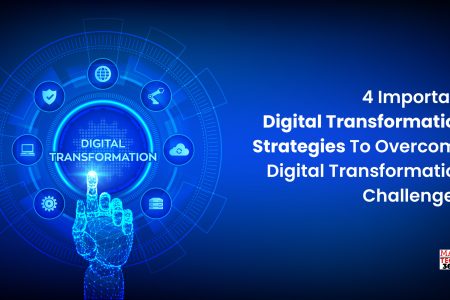Digital transformation (DX) refers to the incorporation of digital technology into all areas of a business. However, Digital transformation is different for every industry. The incorporation of a digital technology helps in changing the way a business functions and interacts with customers. Simply put, when an organization undertakes digital transformation, it basically invests into radical rethinking of using technology to change the business performance.
When it comes to the successful implementation of a digital transformation, businesses need to come up with relevant digital strategies. A digital strategy involves the application of digital technologies to business models in order to create and explore the different business capabilities. It helps in overcoming the challenges of a digital transformation. As more and more businesses are opting for a complete digital transformation, all business strategies will become digital strategies in the near future.
Digital strategy uses technology to improve the business performance. This can involve the creation or innovation of new products or reimagining a business’s current processes. However, the whole digital transformation process has its own set of challenges (this also depends on the business you are into). Here are 4 important digital transformation strategies you can use to overcome digital transformation challenges.
Use effective digital technologies
The first and most important digital transformation strategy is to leverage effective digital technologies. Actively invest in digital technologies and use digital technologies that have proven to be effective and efficient in the past. To use effective digital technologies, you need to find the right digital technologies, considering your business. This helps in attracting the attention of your potential customers and motivates them to use your company’s new and improved digital platform.
Effective digital technologies involve the use of project management tools, time tracking tools, social media management tools, etc. Leveraging these kinds of digital technologies will help in building value and improve the efficiency of your business models. Prioritizing the implication of effective digital technologies as a digital strategy further empowers your business’s productivity.
When discussing being effective and efficient, cloud technologies including artificial intelligence take the first seat. All businesses and organizations are incorporating AI to outperform their competitors and trying to rule the market. Most of the time, we relate to AI in the context of machines thinking like human but it can also be taken as using advanced algorithms developed for conducting pre-defined tasks within a set of proper inputs. Despite conventional automation, AI-operated processes help interpret new information. AIs are competent in self-rectification and can adapt to any new challenges coming its way.

Improved cybersecurity
As important as security concerns are perceived, often they are not the topmost priority of many organizations. This is the biggest contributing factor for security breaches in any organization’s system. The digital world is growing and expanding rapidly, making way for many viruses and cyberattacks on your entire system.
This makes it even more important to ensure all your confidential information and data are securely kept within the company. Make sure that all your network connections have VPNs, change your passwords every month, installing Google chrome’s ad blocker etc., are some common practices you can undertake to avoid security breaches and the disruption of your business operations.
According to the predictions by Gartner, it anticipates that contemporary data privacy laws will encompass the personal information of up to 75% of the world population. On an average, out of the 90%, the financial costs of security incidents will be reduced if the organizations start adapting the cybersecurity network in 2024. It has also been stated that by 2025, almost 60% of companies will integrate cybersecurity risk management as a primary factor in analyzing third-party transactions and maintaining business relationships. Moreover CEOs today are also preparing to tackle cybercrime by installing softwares regarding that.
Invest in user-friendly digital systems
To reduce the struggles of the human workforce the implementation and application of proper digital systems is a must. User-friendly digital systems help by performing daily tasks and functions thus, reducing manual efforts. For more output in less time effective and user-friendly digital systems are important. Ensure that the digital systems you are investing in are user-friendly, meaning, the systems are very easy to operate, navigate, install, and can be removed without the intervention of third-party software.
Lets understand this through an example of document management solutions (DMS) software which is a digital solution that caters to the organization in all the processes such as identifying, storing, managing and tracking documents. This kind of software works by understanding critical business information, which helps to start, execute and end the processes in predictable and measurable manner. The features of these software also include integrating e-signatures to eradicate the need for hard copies, scanning and waiting for signed files to be given.
Leverage Data Analytics for data-driven decision making
Data analytics allows businesses to make decisions based on relevant and important statistical facts. These facts are the building blocks to make better business decisions for the company’s growth in future.
Cloud and data analytics perform many tasks for the entire business and also extract patterns and detect the ongoing trends. It allows you to look at the bigger picture by providing answers to everyday corporate queries such as, what products your customers are buying? What are your potential customers talking about? etc. Data analytics provides a long-term view of the market and competition for businesses to come up with their next step.
Digital transformation is different for every organization, and this makes the need to have digital strategy even more important.
Wrapping it up
Digital transformation is taking place every now and then before the COVID-19 pandemic, the aim of organizations was to enhance their customer experience but after the pandemic this transformation has been the center of all operation and innovation. The goal of digital transformation is not just to remain a mere technology, which completes normal traditional tasks, but to drive towards growth and development with new innovations, which can help the business to shift the mindset in reimaging new business models and processes.
